|
To further enhance the Tokyo Marui
Abrams, extra accessories were added to the model. 1/24 scale modern military items are difficult to come by, thus I fabricated
most of the accessories seen stowed in the bustle rack.
An Abrams tank has a large external bustle rack to contain crew gear and supplies. Despite its size, the interior
of the tank is quite cramped; much of the space is used for armor. Working from photos, most of the external gear consists of ALICE packs, duffel bags, water cans, tarps, bedrolls, nests, and ammunition containers. Although abundant
in 1/35, and 1/16 scales, these detail items are difficult to find in 1/24 scale, and the majority of model car accessories
are not suitable for use in tanks. Fortunately, tank crew gear can by scratch
built easily from sheet plastic or sculpted from epoxy putty. Since I would need multiples of these items, I made only one
original, and several copies cast from resin. A list of items follows:
APU -
The Abrams carries an external Auxiliary Power Unit (APU) in the left rear of the bustle rack. It provides power to the turret
systems when the main engine is shut off. Weighing several hundred pounds it displaces crew gear in the bustle racks, necessitating
all sorts of jury rigged stowage by the crew. Exact dimensions of the APU are difficult to track down, so working from published
photographs, I created a test sample from thin plasticard. This sample APU was then place into the bustle rack, compared
to the photos, and refinements in size were incorporated into the final APU.
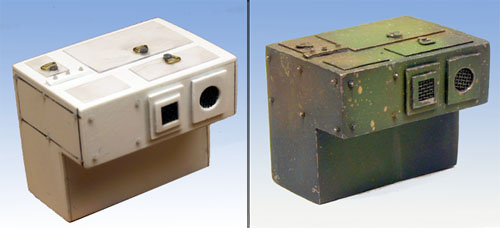
|
| The turret APU is also used on M1A1 tanks |
The body of the APU is
white plasticard, 3 thou thick. Lifting hooks were made from brass wire, and the service panels on the top of the APU were
cut from the clear blister plastic found on packages. Metal mesh was used for the vents, and the entire unit was painted to
match the rest of the tank.
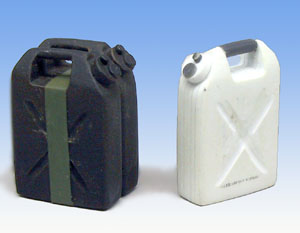
|
| 2 water cans on the left have been strapped together |
Water
Can- The actual water can is made from plastic, holds 5 gallons, and has a screw
cap with an air relief valve. I made my miniature copy by laminating several sheets of plastic, then filing out the rough
shape of the water can. It was then smoothed with fine grit sandpaper, and the
carrying handle and cap were added from different diameters of plastic rod. Water cans are now manufactured from a tan colored
plastic. While black plastic cans are still available, they are rare. The color used is very similar to Tamiya's modern armor
tan plastic.
ALICE packs and Duffel bags-
The ALICE pack has been in use by American troops since the Vietnam War. The
medium sized rucksack is made of nylon, lightweight and can be used without a metal frame. It is issued to troops, and is
often mounted to the turret sides by an Abrams tank crew to hold their personal gear. I sculpted 2 different ALICE rucksacks out of Kneadatite
epoxy putty, and cast 2 copies each, for a total of four. Thin plastic strip was then heated over a candle and bent to shape
to simulate shoulder straps. I used paper strips to replicate the tiny straps on the three smaller pouches on each rucksack.
After painting, I used a Rapidiograph pen to write the tiny "US" stencil on the front flap of the rucksacks.
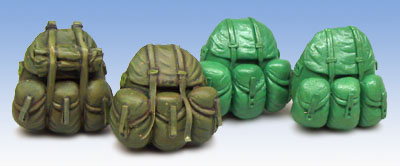
|
| The 2 compression straps are made from thin strips of paper |
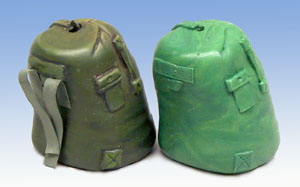
|
| The wide shoulder straps attach to the turret bustle rack |
The large duffel bag see
in the bustle racks are issued to troops to hold their non-essential gear moving to and from a theater of conflict. It is
not intended for use in combat. The duffel bags are made of cotton, top loading, and have shoulder straps and document pocket.
I sculpted a duffel bag again out of Kneadatite, and cast two copies for use. To be accurate, a carrying handle, document
pocket, and top loading flap were sculpted on as well. Shoulder straps made of paper completed each bag.
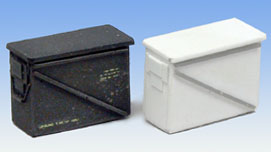
|
| Tiny wire handles are added to the 20mm can sides |
20mm Ammo
Cans- When the Abrams tanks were upgraded with an NBC (Nuclear Biological Contamination) system, valuable
storage space in the form of a hull storage bin was lost. Crews in the field remedied this problem by attaching 20mm ammo
cans to the rear bustle rack. Four are usually carried, one for each crew member. The containers are watertight, and help
keep personal items dry when the tank is on maneuvers, and are also used to carry lubricating oils, straps and other gear.
They are normally attached using U bolts and holes are drilled or punched into the cans in the proper place.
I made a 20mm ammo can
from sheet plastic. Thin plastic rod was used to replicate the reinforcing strip found on the front of the container, and
tiny brass wire was used to replicate the lid locking mechanisms. Verlinden dry transfers were used to simulate the yellow
stenciling on each box.
Tarps,
Bedrolls, and Tent rolls- Very little of the sleeping gear is kept
inside the cramped turret because they are a fire hazard. The crews often sleep outside of the tank, with issued bedrolls,
tents or sleeping bags. I recreated these various items with tissue paper, cut to shape. Tarps were draped over other stowage
gear, allowing realistic folds to form, and then stiffened with a dilute white glue solution.
Sleeping bags were rolled up, and tied with string, and pressed flat against the turret sides. They were also stiffened
with dilute white glue, and tape straps were added. Buckles are either photo etched from Verlinden or whittled from plastic
stock.
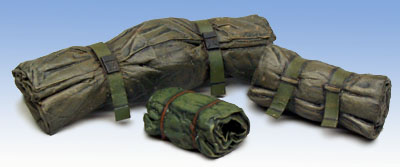
|
| The tent roll features tiny Fastex buckles |
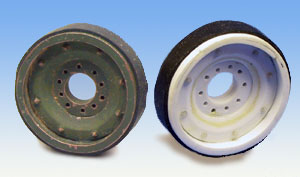
|
| A compass cutter is essential in cutting plastic disks |
Spare Road Wheel- Using the original Marui road wheel as an example; I made a spare road wheel by laminating
several sheets of plastic, and cutting it out in a circular disc shape. I then laminated 2 thin strips of plastic around the circumference
of the disc, to replicate the outer rim. Holes were drilled in the center for the suspension arm and attaching bolts. Filler putty was used on the inside of the wheel to build up an angled inner
surface. After painting, a thin strip of rubber cut from a bicycle inner tube was attached to replicate the raised rubber
wheel surface.
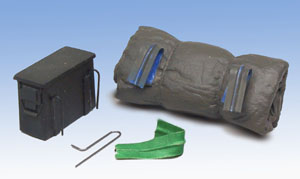
|
| The piano wire clips are thin enough to be almost invisible |
The 20mm ammo cans, and
spare road wheel are attached to the turret grab rails with clips made from steel wire. Other gear such as tent rolls, and
ALICE packs are attached with soft twist wire found
with food items. This allowed the accessories to be removed if there is a need to open up the turret for maintenance without
damaging them in the process. The metal clips provide enough tension to hold
the gear in place when the tank is traveling over rough ground!
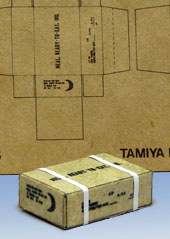
|
| MRE's are actually quite tasty! |
MRE Boxes-
The MRE, or Meals Ready to Eat, are prepackaged food for US troops. Developed by the Army, each case includes 12 vacuum packed
meals that can be eaten hot or cold. There are 12 different menus in a box, and each soldier is issued 4 meals per day. A
tank such as the Abrams will carry several boxes on field maneuvers. The MRE
cases on my Abrams are the more common 12 meal variety. Some troops have 24 meals packed into a bigger box. My MRE boxes are
scanned copies of Tamiya's card stock cases. After scanning the original Tamiya cases at 300 dpi, I color corrected the image,
and resized them to 1/24 scale in Photoshop 6.0. I then printed 4 copies, cut them out and folded each box into shape, with
white glue. A thin piece of white paper replicates the plastic shipping strap on real MRE cases. Be sure to seal the cases with a flat overspray to prevent the ink on the boxes from running if exposed
to moisture.
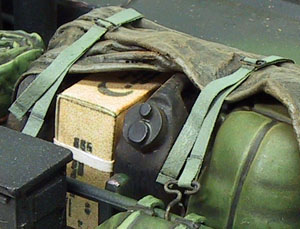
|
| Needle nose tweezers are essential for threading the buckles |
Straps-
Most of the loose gear in the bustle rack are secured with straps made from paper currency. The high fiber content of paper money makes it quite strong when cut into thin strips. They also drape
realistically on the gear, and are attached with small drops of CA glue. With a bit of paint and Verlinden photoetched buckles,
they resemble the ratchet straps used to secure real equipment. The ends of the straps attach to the bustle rack via loops
made from thin brass wire twisted into shape.
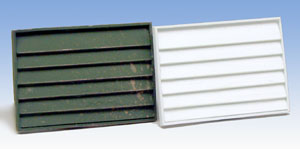
|
| CIPs are angled upwards to reflect the cooler air temperature |
CIP- The Combat Identification
Panel is a device fitted to the surfaces of American combat vehicles. They are designed to appear as a contrasting color when
viewed from a thermal imaging sensor at long distances, signifying an allied vehicle to prevent fratricide. The Abrams tanks
usually carry the corrugated shaped CIPs on the turret sides and rear. I replicated my CIPs by using thin strips of plastic
glued together at an angle, and then mounted in a plastic sheet frame.
To continue, click on the link below:
Carrying Case
|

